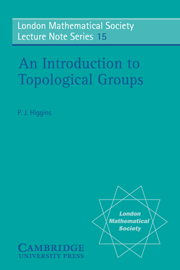CHAPTER III - Integration on locally compact groups
Published online by Cambridge University Press: 05 June 2013
Summary
Abstract integrals
We seek to construct an ‘integral’ on a locally compact group. This may be done by a variety of methods; we wish to avoid measure-theoretic methods and so we take as our model the construction of the Riemann integral on (R, +). There we have the set R of all Riemannintegrable functions (vanishing outside some interval), and a map ∫ : R → R defined by
which satisfies:
(i) Linearity: ∫(λf + μg) = μ∫g.
(ii) Positivity: f ≥ 0 ⇒ ∫f ≥ 0.
(iii) Translation-invariance: if for some fixed a ∈ R and all x ∈ R, g(x) = f (x + a) then
∫g = ∫f.
These three properties actually characterize the Riemann integral up to a scalar multiple. (Exercise.) The same is true if we consider only continuous functions on R, and this suggests that we should try to construct, for more general groups, an integral with similar properties for realvalued continuous functions.
From now on we shall only consider locally compact spaces and groups, and we shall always assume that they are Hausdorff.
For a space X, K(X) denotes the set of all continuous functions X → R with compact support, where
support(f) = closure of {x ∈ X;f(x) 0}.
- Type
- Chapter
- Information
- An Introduction to Topological Groups , pp. 61 - 82Publisher: Cambridge University PressPrint publication year: 1975

